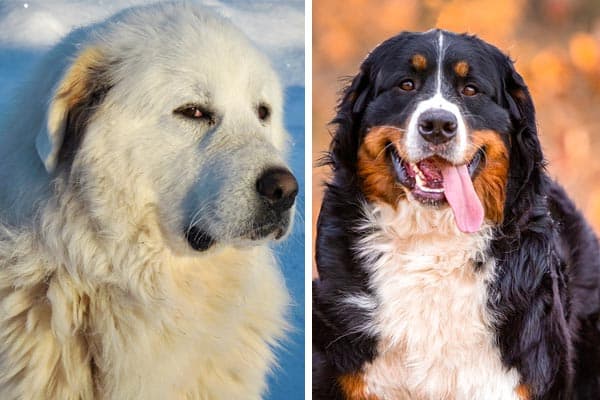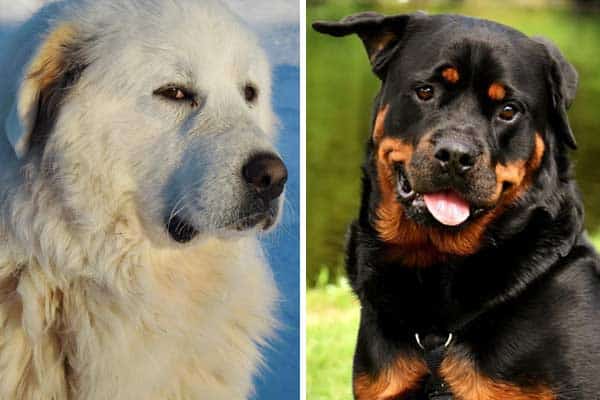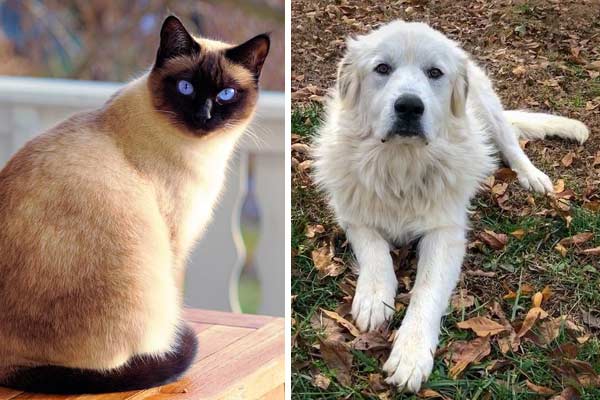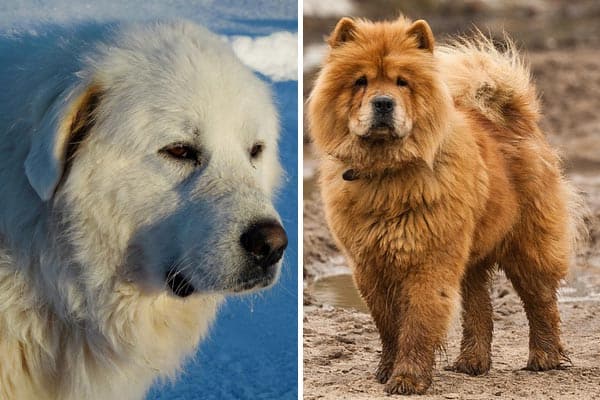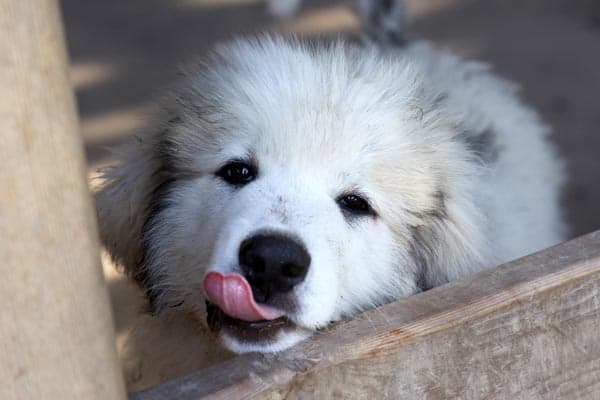Maremma Sheepdog vs Great Pyrenees: Two Ways to be Great at What They Do
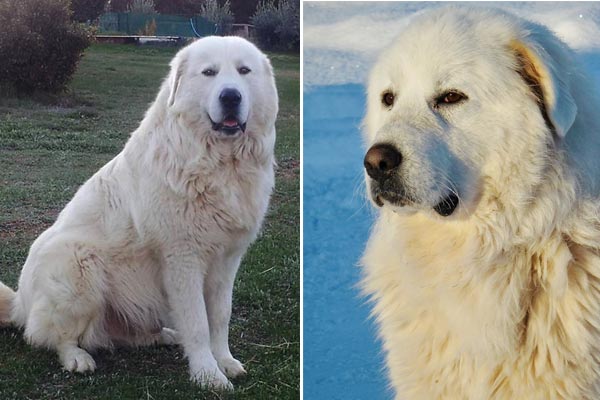
You would not be the first dog lover to wonder what the difference is between all those livestock guardian dogs. You might be especially curious about the white ones.
For example, the Great Pyrenees and Maremma Sheepdog are commonly used LGDs in the US, but how can you tell them apart? Does one have any advantages over the other?
The Maremma Sheepdog vs Great Pyrenees is a smaller dog with wavier fur and a thinner coat. Other structural differences between the breeds are apparent in the head, ears, body, and tail.
The two livestock guardian dogs share dignity and majesty as well as an affinity for children and other dogs.
Maremma Sheepdogs tend to be friendlier to strangers and more trainable than the Great Pyrenees which are more protective and adaptable to family life inside a home. They also have different styles of flock guardianship.
Where did it begin for the Maremma Sheepdog vs Great Pyrenees?
The Maremma Sheepdog hails from Italy
Maremma Sheepdogs are ancient, and their ancestors came from the Tibetan Mastiff. Despite its name, the Tibetan Mastiff is a lupomolossoid, distinguished from the Molossoid or true Mastiff by its direct descendants from wolves and not just Molossers.
The Maremma’s full Italian name is Cane da Pastore Maremmano-Abruzzese revealing its start as two separate breeds.
A livestock guardian dog of a similar type had developed in each of the regions Maremma and Abruzzo in Italy during Roman times around 20 AD.
Because of the nomadic nature of shepherds and their flocks, dogs from different regions had ample opportunities to interbreed.
The Italian national dog registry, the Ente Nazionale della Cinofilia Italiano, merged the Maremma and Abruzzo types in 1958.
Maremma Sheepdogs arrived in the US in the 1970s as part of a research project on the use of LGDs as a nonlethal way to control predators of livestock.
Maremmas were a large part of the project as were Anatolian Shepherds, and both continue to be employed in such a capacity into the 2020s. The Maremma is not an AKC breed but joined the UKC in 2006 under the guardian group.
Great Pyrenees had their start in France
Known as the Pyrenean Mountain Dog in Europe, the Great Pyrenees originated in the Pyrenean Mountain along the border of France and Spain. Fossil remains suggest these dogs’ ancestors could have been in existence as early as 3000 BC.
Historians believe white guardian flock protectors first originated in Asia minor or present-day Turkey over 10,000 years ago. Most of the old white LGDs are thought to have Tibetan Mastiff infusions in their heritage several thousand years later.
The Great Pyrenees arrived in France and were further developed by Basque shepherds between 3000 and 1300 BC. Basques were also renowned for their high-quality herding dogs and sheep.
The Great Pyrenees’ main duty was to guard the flock from wolves and rustlers. It was also an effective deterrent against other predators like bears, mountain lions, and coyotes.
In the 1600s the Great Pyrenees obtained the notice of Louis XIV and began guarding the chateaux.
Gilbert du Motier, Marquis de Lafayette, or simply General Lafayette introduced the Great Pyrenees to the US in 1824. The breed joined the AKC in 1933.
How can you tell Maremma Sheepdogs and Great Pyrenees apart?
Maremmas are not as similar to Great Pyrs as a couple of the other white guardian dogs. If you know what to look for, you can readily discern the differences between the Maremma Sheepdog vs Great Pyrenees.
The Maremma is 25.5 to 28.75 inches tall at the shoulders, according to the UKC breed standard. It should weigh between 75 and 100 pounds. Females are smaller with a height of 23.5 to 26.5 inches and a weight of 66 to 90 pounds.
Great Pyrenees dogs are both taller and heavier than Maremma Sheepdogs. Males stand 28 to 32 inches tall at the withers and weigh 100 to 160 pounds while females have a shoulder height of 25 to 29 inches and range from 85 to 110 pounds in weight.
Head
A Maremma Italian Sheepdog has a conical shape to its head. When you see one head on you should immediately recognize the similarity to a bear. There is not much of a stop, and in that respect, the Maremma most closely resembles the Great Pyrenes in profile.
The skull is broad with a wide and deep muzzle. The snout is slightly shorter than the back skull and tapers ever so slightly to the tip.
A Maremma’s eyes are medium in size and can be almost black or chestnut. Another pronounced deviation from the Great Pyrenees is the Maremma’s ears, which are high-set, small, triangular, and hanging. They are almost as mobile as erect ears because of their high carriage. You will see cropped ears in some working field dogs.
The Great Pyrenees head is more of a wedge shape with a gradually sloping stop that makes it barely perceptible. The crown has a slight rounding as opposed to the Maremma whose skull is flat on top.
The Great Pyrenees has small- or medium-sized ears that lay flat against the head. The eyes are also medium-sized and almond-shaped but are set at a slight slant.
Both breeds should have dark-rimmed eyes and a black nose. Another difference is that the Great Pyrenees’ muzzle is the same length as its skull.
Body
A Maremma Sheepdog has a rather short neck that is thick and strong. It lacks a dewlap and blends smoothly into the withers and long shoulder blades.
Maremmas have powerful limbs that are heavy in bone. Maremmas have high withers and a broad back. They are slightly longer than tall with a level topline and sloping croup.
They are rather long through the loin (opposite a compact, short-coupled dog) and have a mild tuck-up of the abdomen from the end of the ribs to the hips. The chest is round and deep.
Pyrs have a neck that is medium in length and has a slight dewlap. Like the Maremma, the Great Pyr neck blends seamlessly into the withers and well laid back shoulders that allow the dog to move freely in the front. Both sets of limbs are muscular with medium bone substance.
Great Pyrenees Dogs are slightly longer than tall with a level topline and a gentle slope to the croup. Pyrs have less of a sloping croup and more of an abdominal tuck-up than Maremmas.
The chest is deep and oval, and the rear paws toe out slightly. The Great Pyrenees must have the characteristic double dewclaws on the hind legs.
Tail
A Maremma’s tail follows the line of the croup and thus is set quite low. It hangs down when the dog is relaxed and comes up to the level of the back when she is working or becomes excited. There is often a hook at the end of the Maremma Sheepdog’s tail.
The Great Pyrenees’ tail is also set low, albeit not as dramatically at the Maremma. When calm, the tail hangs to the hocks with a hook or shepherd’s crook at the end.
During movement, a Great Pyrenees can either carry her tail low or over her back in an attitude known as making the wheel.
A distinguishing feature of the Pyr is the elaborate plumage of the tail. The Maremma’s tail has furnishings but nowhere near to the extent of the Great Pyrenees. It should never have plumes or even fringes.
Coat
Often wavier than the Great Pyrenees’ coat, the Maremma’s breed standard actually calls for straight fur. Waves are permissible but curls are not.
Whether straight or wavy, the coat should be rather harsh and lay flat. There is a dense undercoat that the dog typically loses during warmer seasons.
The fur is longer around the neck to form a collar and shorter on the face and ears. You will notice mild fringing on the backs of the upper legs.
If you cannot discern any other differences, you will undoubtedly notice the deviation in the Pyr’s coat from the Maremma. It is also a double coat with straight, coarse, medium-long outer hairs that lay flat.
However, it is much more luxurious than the Maremma with a thick woolly undercoat, a generous ruff or mane around the neck and shoulders, and feathering on the upper front and back legs. Very slight waves are tolerable.
The Great Pyrenees can typically withstand temperatures that are 20 degrees colder than can the Maremma Sheepdog. Both can tolerate temperatures up to about 85 degrees Fahrenheit although that is not their preference.
Colors
Maremma Sheepdogs should be solid white. You may occasionally see subtle shading throughout the coat of orange, lemon, or ivory. Some dogs may have black shading or Isabella patches, but these anomalies are a disqualification in the show ring.
The Great Pyrenees is also solid white. Instead of subtle shading, they can have orange, badger, tan, or gray markings that are usually limited to the head, ears, and base of the tail. Pyrs can have patches on their bodies if they do not account for over 30% of the dog’s color.
Maremmas resemble Pyrs in Personality.
As mentioned, Maremmas and Pyrs are loyal, calm, patient, nurturing, and protective. The Maremma is friendlier and the Great Pyrenees more strong-willed.
Maremma Sheepdogs tend to be more cooperative in training different skills, but they find it more difficult to adapt to living indoors. Both breeds exhibit patience and gentleness around children, although they are still too large and powerful to leave alone with kids.
Neither breed is going to be extremely playful with either children or other dogs. There are individual variances, but most LGDs are serious animals.
Maremma Sheepdogs are more active than Pyrs but with a lower wanderlust. Maremmas also bark less than the Great Pyrenees.
Different Guarding Styles
Maremma Sheepdogs have a unique guarding style in that when a predator appears, they huddle livestock in the middle and guard the perimeter of the group. They do not leave their charges in pursuit of wolves.
The Great Pyrenees intimidate predators by barking loudly. If barking and posturing are not effective, the Great Pyrenees will try to chase the predator away.
Only if all else fails will they engage in a physical confrontation. Fights between LGDs and predators are uncommon as most would-be thieves will seek easier prey.
Health problems of Maremma Sheepdogs vs Great Pyrenees vary slightly
Bothe Maremmas and Pyrs live a long life for their size. Maremma Sheepdogs have a life expectancy of 11 to 13 years and the Great Pyrenees from 10 to 12 years.
Maremma Sheepdog Issues
- Eyelid abnormalities – Ectropion (eyelids droop) or entropion (Eyelids roll inward)
- Hip dysplasia
- Elbow dysplasia
- Bloat or GDV – stomach distends with fluid or gas and flips
- Luxating patellas
Great Pyrenees health
- Hip dysplasia
- Elbow dysplasia
- Bloat
- Cataracts
- Progressive retinal atrophy – retinal loses cells leading to blindness; genetic problem
- Luxating patellas
- Addison’s disease – do not produce enough steroids for everyday stresses
Caring for your Maremma Sheepdog vs Great Pyrenees is not too different
Despite their thick coats, the grooming needs of Maremmas and Pyrs are minimal. You simply need to prevent the coat from tangling, which it is not prone to do.
The most important task you have besides feeding your dog is training and socialization.
- Grooming – once or twice weekly, daily when shedding undercoat
- Trim nails – every 4 to 12 weeks, rear dewclaws on Great Pyr every 4 to 6 weeks
- Check ears every few days
- Exercise – 40 to 90 minutes daily; Maremma needs a bit more than Great Pyr
- Feeding – mostly proteins, then fats, then limited carbohydrates if any
- Training – Daily as a puppy, ongoing as adults; Great Pyr needs more obedience; LGD training is mostly through seasoned working dogs
- Socialization – nonsocial dogs of both breeds are likely to develop inappropriate aggression towards people and other dogs
- Calories – puppies need 50 to 80 calories per pound of body weight per day, adults require 22 to 35 calories per pound of body weight per day depending on age and working status
Videos of Maremma Sheepdog vs the Great Pyrenees
Maremma Sheepdog
- Higher earset
- Coat less dense
- Different head shape
Great Pyrenees
- Thicker coat, especially mane
- Different earset
- Head dramatically different
